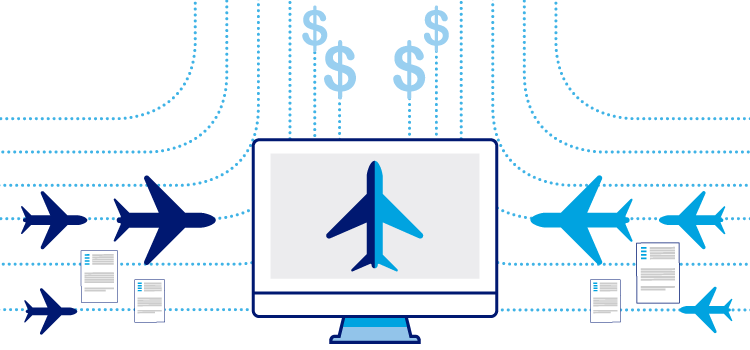Top Flutter Developers for Hire – Trusted by Fortune 500 Companies, Software Product Companies & Startups
Are you looking to create an exceptional cross-platform app using Flutter? As more businesses embra
Pujitha, August 18, 2019

As per Boeing and Airbus, the commercial market outlook 2019-2038, the number of commercial operators that they had forecast in 1961 has increased to nearly 200 and passenger traffic has grown by a factor of nearly 70. More recently, since 2000, the global airline network has expanded 2.5 times, while industry innovation and productivity have enabled travelers to fly for nearly 40 percent lower average fares in real terms.
The industry growth has affected revenue management in a positive way and giving it new capabilities that weren’t there before.
But can we already say that all airline revenue management issues are resolved? Can we say that it has been shaped to its final look and it’s now efficiently functioning for the good of airlines? Or should we expect more changes to come in the future?
To answer these questions, we have to diagnose whether current revenue management technology is effectively supporting the business strategy of airlines. We also have to ask whether the effect of airline revenue management is positively reflected in traditional revenue management KPIs.
Let’s start by looking at the key revenue management processes.
Using AI and Machine Learning to estimate the “Demand Forecast”
Challenges: The traditional way has been based on historical data, with adjustments for the day of the week, season, special events, and various other factors.
Apart from accuracy concerns, implementing a historical-based forecast could also become complicated if an airline doesn’t have enough historical data on certain routes. This could be the case if an airline is just starting its operations or opening a new route.
Solutions Now: Dedicated research is now going on to see how machine learning algorithms could leverage information about the outside world to improve demand forecasting and provide more accurate results compared to the traditional model.
Even though this approach sounds new, some airlines have already looked at the possibilities of using artificial intelligence to forecast demand for their products.
At the global scale, however, there’s a still a way to go. Many airlines still don’t trust the basic forecast that their revenue management systems provide. Needless to say, the capability to forecast product elements other than a seat is not available to most airlines.
Taking the current seat-only demand forecast to a new level of accuracy and being able to forecast demand for other product elements, like ancillary services, will occupy airline revenue managers in the years to come.
Price Optimization
Challenges : Final Ticket Prices
Despite the recent dynamic pricing boom in the airline industry, the optimization of ticket prices still remains completely detached from the optimization of seat availability.
Most revenue management systems on the market aren’t capable of optimizing the final ticket price. Instead, the revenue management system just tells the airline’s PSS system how many seats could be sold in each booking class. The price itself is then optimized separately by the pricing department.
The separation of product availability and pricing processes has become the norm in the airline industry. There’s a lack of capability to combine both processes. However, this would seem completely impractical in other domains.
If we compare it to the shopping at the supermarket, that would mean selecting your products first, without having an idea of the price until you’re at the checkout later. How practical would that be? Not practical at all.
To deal with this issue and reach a state of the art dynamic pricing solution, price optimization should first be integrated within airline revenue management systems to align availability and pricing decisions.
In the future, we’re likely to see airlines and vendors taking such steps and perhaps even removing booking class structures completely.
Sound complicated enough? It is. However, it’s still not the end of the airline pricing challenge. The next level of complexity the airline industry will face in the future is the optimization of price for the entire product bundle, including ancillaries and third-party content.
Airline Metrics
We can now conclude that airline revenue management systems still have a long way to go, before reaching the holy grail of airline revenue management. But what are airline metrics telling us about the current state of affairs?
If we look at the latest IATA statistics, we see that passenger traffic (RPKs) and passenger capacity (ASKs) have been steadily growing around the world in the last five years. However, passenger revenue and yield have been less stable.
This tells us that both demand and supply are increasing, but average fare is slightly declining. This has also been confirmed by some of the airlines lately, despite IATA’s positive outlook for 2019.
More robust price optimization with the integration of dynamic pricing would definitely be the key to reaching IATA targets.
Let’s not forget about passenger load factor, which has been growing steadily in the last five years. It’s now reaching a record high of 81.9% globally, with an even higher load factor of 82.1% forecast for 2019.
Based on 2017 figures, the highest load factors achieved so far have been 88.4% among full-service carriers and 96% among low-cost carriers.
If we consider 92.2% as an average between the two, then at the current rate it would take 22 more years to get there globally. But can we get there faster? And would it only be through revenue management efforts?
Marketing teams already directly impact load factor through advertising campaigns. But today’s marketing and revenue management efforts to maximize load factor are not aligned.
What could be the magic formula to bring both efforts together?
Other Latest Trends and Complications
Are you looking to create an exceptional cross-platform app using Flutter? As more businesses embra
Are you looking to create an exceptional cross-platform app using Flutter? As more businesses embra
Are you looking to create an exceptional cross-platform app using Flutter? As more businesses embra
Are you looking to create an exceptional cross-platform app using Flutter? As more businesses embra


